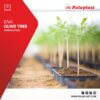
AVOCADO: Cultivation characteristics and irrigation techniques
- Avocado (Persea americana, Gen.: Lauraceae) is an evergreen tree of the tropical regions of Mexico and Central America, which is subdivided into 3 botanical types: the Mexican type, which is the most cold-resistant, the Guatemalan type with less cold resistance, larger fruits and pleasant taste and the West Indian type which thrives in hot and humid conditions.
- The avocado is a large tree, 5-15m high, sometimes even reaching 20m. It starts fruiting in the 3rd – 6th year of its age and comes into full fruiting at the age of 12 – 18 years. Avocado productive life reaches 25 – 35 years. Each shoot bears 1 to 2 fruits, and has two or more bearings per year (spring – summer).
- As a subtropical species, it has special climatic requirements as it needs a warm climate and a relative humidity of 60-65%. Important factors to be taken into account are appropriate soil pH, low carbonate content, low salinity, good soil drainage and zero history of soil-transmitted diseases. Planting distances are determined by soil fertility, rootstock and the cultivar and are usually 5m x 6m in the form of a rectangular frame. Particular care must be taken when planting young trees, as they are very sensitive to sunburn, so it is necessary to protect the trunk and branches by shading or painting.
- In recent years there has been an increase in cultivation areas, with Mexico being the main producing country, while in Greece there is also an increasing dynamic of cultivation in Crete, as well as in the citrus cultivation zones in general.
AVOCADO IRRIGATION
What are the water needs of avocado cultivation?
Avocado, as it grows its roots horizontally, is sensitive to lack of water but also to excessive moisture, as well as to the quality of irrigation water. Critical periods for the irrigation of plants are: the flowering-fruiting, the formation and growth of the fruit, and the period of ripening of the fruits in order to avoid fruit fall. In general, it is important to water the avocado as close to the required amount of water as possible, as applying too large amounts can lead to increased filtration rates of water and nutrients to depths that cannot be absorbed by the plant or cause root suffocation problems with the development of fungal diseases, especially in poorly drained soils.
Which are the main irrigation techniques used in avocado cultivation?
There are two main irrigation techniques used in avocado cultivation:
- Drip irrigation, which can be set up as follows: for new plantations, the average summer daily irrigation needs are set at 10-20 lt/tree/day in the first year of plantation, rise to 20-40 lt/tree/day in the third year of plantation and reach the 50-100 lt/tree/day after the fourth year, depending on the variety and soil – climatic conditions. The limits of required quantities for the rational use of irrigation water in the developed trees are set at 600 – 700 mᵌ/acre/year.
- Irrigation with sprinklers and spraying water under the crown, which gives good results mainly in sandy and sloping soils and has a wide application. It is important to create a proper study for the installation in terms of operating pressure, sprinklers as well as operating time for each terrain.
Which is the most advisable of the main irrigation systems applied to avocado cultivation?
Drip irrigation is considered the most appropriate system, as it contributes significantly to water saving, thus enhancing the overall effort for water saving.
Palaplast has a wide range of products that can be used to install a reliable and efficient drip irrigation or micro-sprinkler irrigation system for avocado plantations:
- Irrigation pipes AGROPAL HDPE 80 και LDPE
- Pressure Compensating Driplines, Driplines (Paladrip – Palaplast, Paladrip-XL – Palaplast, Paladrip-Slim – Palaplast)
- Dripline fittings
- Microsprinklers and fittings (Pal Rotating Super Sprayer, Pal Rotating Special Sprayer, Dual adjuster, Spike)
- Clamp saddles
- Filters


